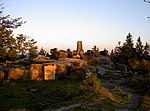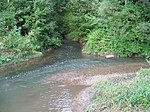Externsteine

The Externsteine ([ˈɛkstɐnʃtaɪnə]) is a distinctive sandstone rock formation located in the Teutoburg Forest, near the town of Horn-Bad Meinberg in the Lippe district of the German state of North Rhine-Westphalia. The formation is a tor consisting of several tall, narrow columns of rock which rise abruptly from the surrounding wooded hills. In a popular tradition going back to an idea proposed to Hermann Hamelmann in 1564, the Externsteine are identified as a sacred site of the pagan Saxons, and the location of the Irminsul idol reportedly destroyed by Charlemagne; there is however no archaeological evidence that would confirm the site's use during the relevant period. The stones were used as the site of a hermitage in the Middle Ages, and by at least the high medieval period were the site of a Christian chapel. The Externsteine relief is a medieval depiction of the Descent from the Cross. It remains controversial whether the site was already used for Christian worship in the 8th to early 10th centuries.
Excerpt from the Wikipedia article Externsteine (License: CC BY-SA 3.0, Authors, Images).Externsteine
Externsteiner Straße, Horn-Bad Meinberg
Geographical coordinates (GPS) Address Website Nearby Places Show on map
Geographical coordinates (GPS)
| Latitude | Longitude |
|---|---|
| N 51.869 ° | E 8.9173 ° |
Address
Externsteine
Externsteiner Straße
32805 Horn-Bad Meinberg, Horn
North Rhine-Westphalia, Germany
Open on Google Maps









